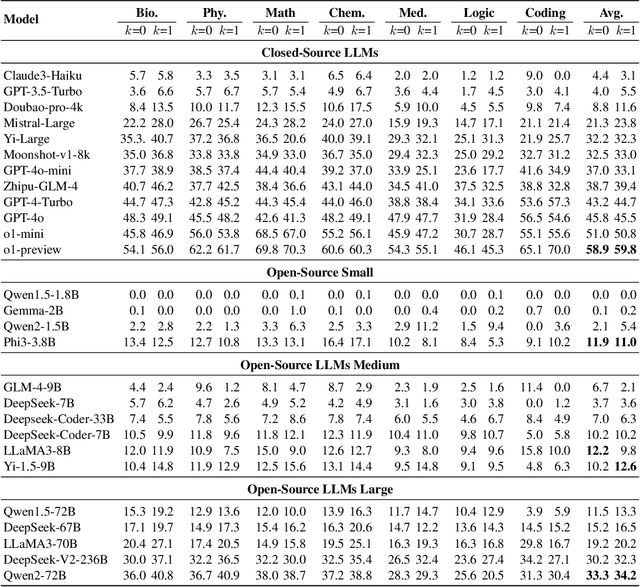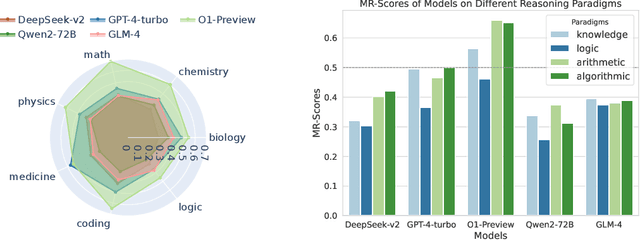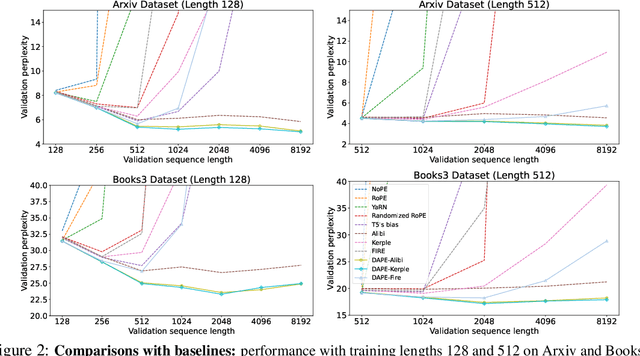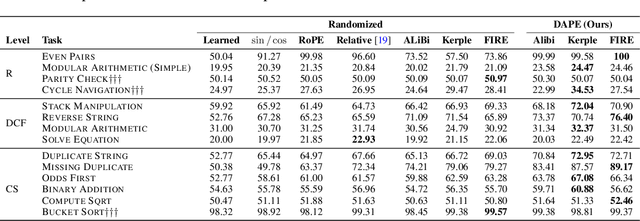Jingyao Li
DynamicBench: Evaluating Real-Time Report Generation in Large Language Models
Jun 26, 2025Abstract:Traditional benchmarks for large language models (LLMs) typically rely on static evaluations through storytelling or opinion expression, which fail to capture the dynamic requirements of real-time information processing in contemporary applications. To address this limitation, we present DynamicBench, a benchmark designed to evaluate the proficiency of LLMs in storing and processing up-to-the-minute data. DynamicBench utilizes a dual-path retrieval pipeline, integrating web searches with local report databases. It necessitates domain-specific knowledge, ensuring accurate responses report generation within specialized fields. By evaluating models in scenarios that either provide or withhold external documents, DynamicBench effectively measures their capability to independently process recent information or leverage contextual enhancements. Additionally, we introduce an advanced report generation system adept at managing dynamic information synthesis. Our experimental results confirm the efficacy of our approach, with our method achieving state-of-the-art performance, surpassing GPT4o in document-free and document-assisted scenarios by 7.0% and 5.8%, respectively. The code and data will be made publicly available.
Logits-Based Finetuning
May 30, 2025Abstract:The core of out-of-distribution (OOD) detection is to learn the in-distribution (ID) representation, which is distinguishable from OOD samples. Previous work applied recognition-based methods to learn the ID features, which tend to learn shortcuts instead of comprehensive representations. In this work, we find surprisingly that simply using reconstruction-based methods could boost the performance of OOD detection significantly. We deeply explore the main contributors of OOD detection and find that reconstruction-based pretext tasks have the potential to provide a generally applicable and efficacious prior, which benefits the model in learning intrinsic data distributions of the ID dataset. Specifically, we take Masked Image Modeling as a pretext task for our OOD detection framework (MOOD). Without bells and whistles, MOOD outperforms previous SOTA of one-class OOD detection by 5.7%, multi-class OOD detection by 3.0%, and near-distribution OOD detection by 2.1%. It even defeats the 10-shot-per-class outlier exposure OOD detection, although we do not include any OOD samples for our detection. Codes are available at https://github.com/JulietLJY/MOOD.
DreamOmni: Unified Image Generation and Editing
Dec 22, 2024Abstract:Currently, the success of large language models (LLMs) illustrates that a unified multitasking approach can significantly enhance model usability, streamline deployment, and foster synergistic benefits across different tasks. However, in computer vision, while text-to-image (T2I) models have significantly improved generation quality through scaling up, their framework design did not initially consider how to unify with downstream tasks, such as various types of editing. To address this, we introduce DreamOmni, a unified model for image generation and editing. We begin by analyzing existing frameworks and the requirements of downstream tasks, proposing a unified framework that integrates both T2I models and various editing tasks. Furthermore, another key challenge is the efficient creation of high-quality editing data, particularly for instruction-based and drag-based editing. To this end, we develop a synthetic data pipeline using sticker-like elements to synthesize accurate, high-quality datasets efficiently, which enables editing data scaling up for unified model training. For training, DreamOmni jointly trains T2I generation and downstream tasks. T2I training enhances the model's understanding of specific concepts and improves generation quality, while editing training helps the model grasp the nuances of the editing task. This collaboration significantly boosts editing performance. Extensive experiments confirm the effectiveness of DreamOmni. The code and model will be released.
Lyra: An Efficient and Speech-Centric Framework for Omni-Cognition
Dec 12, 2024



Abstract:As Multi-modal Large Language Models (MLLMs) evolve, expanding beyond single-domain capabilities is essential to meet the demands for more versatile and efficient AI. However, previous omni-models have insufficiently explored speech, neglecting its integration with multi-modality. We introduce Lyra, an efficient MLLM that enhances multimodal abilities, including advanced long-speech comprehension, sound understanding, cross-modality efficiency, and seamless speech interaction. To achieve efficiency and speech-centric capabilities, Lyra employs three strategies: (1) leveraging existing open-source large models and a proposed multi-modality LoRA to reduce training costs and data requirements; (2) using a latent multi-modality regularizer and extractor to strengthen the relationship between speech and other modalities, thereby enhancing model performance; and (3) constructing a high-quality, extensive dataset that includes 1.5M multi-modal (language, vision, audio) data samples and 12K long speech samples, enabling Lyra to handle complex long speech inputs and achieve more robust omni-cognition. Compared to other omni-methods, Lyra achieves state-of-the-art performance on various vision-language, vision-speech, and speech-language benchmarks, while also using fewer computational resources and less training data.
VisionZip: Longer is Better but Not Necessary in Vision Language Models
Dec 05, 2024



Abstract:Recent advancements in vision-language models have enhanced performance by increasing the length of visual tokens, making them much longer than text tokens and significantly raising computational costs. However, we observe that the visual tokens generated by popular vision encoders, such as CLIP and SigLIP, contain significant redundancy. To address this, we introduce VisionZip, a simple yet effective method that selects a set of informative tokens for input to the language model, reducing visual token redundancy and improving efficiency while maintaining model performance. The proposed VisionZip can be widely applied to image and video understanding tasks and is well-suited for multi-turn dialogues in real-world scenarios, where previous methods tend to underperform. Experimental results show that VisionZip outperforms the previous state-of-the-art method by at least 5% performance gains across nearly all settings. Moreover, our method significantly enhances model inference speed, improving the prefilling time by 8x and enabling the LLaVA-Next 13B model to infer faster than the LLaVA-Next 7B model while achieving better results. Furthermore, we analyze the causes of this redundancy and encourage the community to focus on extracting better visual features rather than merely increasing token length. Our code is available at https://github.com/dvlab-research/VisionZip .
DAPE V2: Process Attention Score as Feature Map for Length Extrapolation
Oct 07, 2024



Abstract:The attention mechanism is a fundamental component of the Transformer model, contributing to interactions among distinct tokens, in contrast to earlier feed-forward neural networks. In general, the attention scores are determined simply by the key-query products. However, this work's occasional trial (combining DAPE and NoPE) of including additional MLPs on attention scores without position encoding indicates that the classical key-query multiplication may limit the performance of Transformers. In this work, we conceptualize attention as a feature map and apply the convolution operator (for neighboring attention scores across different heads) to mimic the processing methods in computer vision. Specifically, the main contribution of this paper is identifying and interpreting the Transformer length extrapolation problem as a result of the limited expressiveness of the naive query and key dot product, and we successfully translate the length extrapolation issue into a well-understood feature map processing problem. The novel insight, which can be adapted to various attention-related models, reveals that the current Transformer architecture has the potential for further evolution. Extensive experiments demonstrate that treating attention as a feature map and applying convolution as a processing method significantly enhances Transformer performance.
MR-BEN: A Comprehensive Meta-Reasoning Benchmark for Large Language Models
Jun 20, 2024



Abstract:Large language models (LLMs) have shown increasing capability in problem-solving and decision-making, largely based on the step-by-step chain-of-thought reasoning processes. However, it has been increasingly challenging to evaluate the reasoning capability of LLMs. Concretely, existing outcome-based benchmarks begin to saturate and become less sufficient to monitor the progress. To this end, we present a process-based benchmark MR-BEN that demands a meta reasoning skill, where LMs are asked to locate and analyse potential errors in automatically generated reasoning steps. MR-BEN is a comprehensive benchmark comprising 5,975 questions collected from human experts, covering various subjects such as physics, chemistry, logic, coding, and more. Through our designed metrics for assessing meta-reasoning on this benchmark, we identify interesting limitations and weaknesses of current LLMs (open-source and closed-source models). For example, open-source models are seemingly comparable to GPT-4 on outcome-based benchmarks, but they lag far behind on our benchmark, revealing the underlying reasoning capability gap between them. Our dataset and codes are available on https://randolph-zeng.github.io/Mr-Ben.github.io/.
QuickLLaMA: Query-aware Inference Acceleration for Large Language Models
Jun 11, 2024Abstract:The capacity of Large Language Models (LLMs) to comprehend and reason over long contexts is pivotal for advancements in diverse fields. Yet, they still stuggle with capturing long-distance dependencies within sequences to deeply understand semantics. To address this issue, we introduce Query-aware Inference for LLMs (Q-LLM), a system designed to process extensive sequences akin to human cognition. By focusing on memory data relevant to a given query, Q-LLM can accurately capture pertinent information within a fixed window size and provide precise answers to queries. It doesn't require extra training and can be seamlessly integrated with any LLMs. Q-LLM using LLaMA3 (QuickLLaMA) can read Harry Potter within 30s and accurately answer the questions. Q-LLM improved by 7.17% compared to the current state-of-the-art on LLaMA3, and by 3.26% on Mistral on the $\infty$-bench. In the Needle-in-a-Haystack task, On widely recognized benchmarks, Q-LLM improved upon the current SOTA by 7.0% on Mistral and achieves 100% on LLaMA3. Our code can be found in https://github.com/dvlab-research/Q-LLM.
RoboCoder: Robotic Learning from Basic Skills to General Tasks with Large Language Models
Jun 06, 2024



Abstract:The emergence of Large Language Models (LLMs) has improved the prospects for robotic tasks. However, existing benchmarks are still limited to single tasks with limited generalization capabilities. In this work, we introduce a comprehensive benchmark and an autonomous learning framework, RoboCoder aimed at enhancing the generalization capabilities of robots in complex environments. Unlike traditional methods that focus on single-task learning, our research emphasizes the development of a general-purpose robotic coding algorithm that enables robots to leverage basic skills to tackle increasingly complex tasks. The newly proposed benchmark consists of 80 manually designed tasks across 7 distinct entities, testing the models' ability to learn from minimal initial mastery. Initial testing revealed that even advanced models like GPT-4 could only achieve a 47% pass rate in three-shot scenarios with humanoid entities. To address these limitations, the RoboCoder framework integrates Large Language Models (LLMs) with a dynamic learning system that uses real-time environmental feedback to continuously update and refine action codes. This adaptive method showed a remarkable improvement, achieving a 36% relative improvement. Our codes will be released.
CAPE: Context-Adaptive Positional Encoding for Length Extrapolation
May 23, 2024



Abstract:Positional encoding plays a crucial role in transformers, significantly impacting model performance and length generalization. Prior research has introduced absolute positional encoding (APE) and relative positional encoding (RPE) to distinguish token positions in given sequences. However, both APE and RPE remain fixed after model training regardless of input data, limiting their adaptability and flexibility. Hence, we expect that the desired positional encoding should be context-adaptive and can be dynamically adjusted with the given attention. In this paper, we propose a Context-Adaptive Positional Encoding (CAPE) method, which dynamically and semantically adjusts based on input context and learned fixed priors. Experimental validation on real-world datasets (Arxiv, Books3, and CHE) demonstrates that CAPE enhances model performances in terms of trained length and length generalization, where the improvements are statistically significant. The model visualization suggests that our model can keep both local and anti-local information. Finally, we successfully train the model on sequence length 128 and achieve better performance at evaluation sequence length 8192, compared with other static positional encoding methods, revealing the benefit of the adaptive positional encoding method.
 Add to Chrome
Add to Chrome Add to Firefox
Add to Firefox Add to Edge
Add to Edge